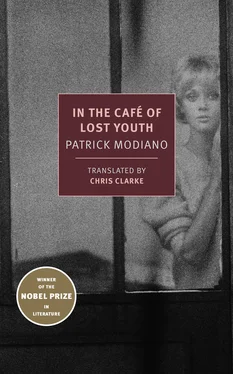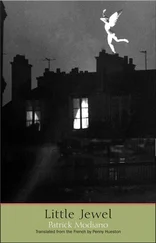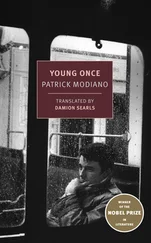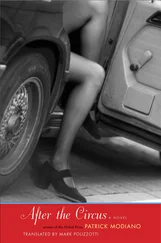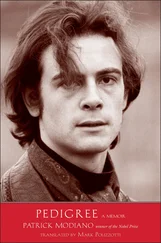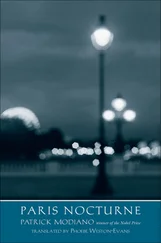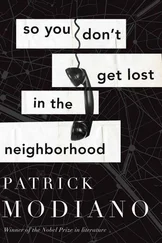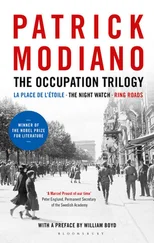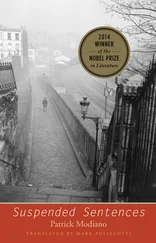She first turned up in October of the previous year. I found a reference point in the Captain’s notebook. “October 15th, 9 p.m. Zacharias’s birthday. At his table, Annet, Don Carlos, Mireille, La Houpa, Fred, Adamov.” I can remember it perfectly. She was at their table. Why didn’t Bowing have the curiosity to ask her name? The accounts are fragile and contradictory, but I am certain of her presence that evening. Everything that made her invisible to Bowing’s gaze had struck me. Her timidity, her languid movements, her smile, and above all her silence. She had been next to Adamov. Perhaps it was because of him that she had come to the Condé. I had often run into Adamov around Odéon, as well as further up around Saint-Julien-le-Pauvre. Each time, he was walking with his hand resting on the shoulder of a young girl. A blind man allowing himself to be guided. And yet he looked as if he was observing everything with that tragic, doglike stare. And each time, it seemed to me, it was a different young girl serving as his guide. Or nurse. Why not her? Well, as it turned out, she left the Condé with Adamov that night. I saw them head down the empty street towards Odéon, Adamov with his hand on her shoulder, advancing with his methodical gait. You might have thought she was afraid of going too fast, and sometimes she would stop a moment, as if to allow him to catch his breath. At the Carrefour de l’Odéon, Adamov shook her hand somewhat solemnly, then she rushed into the mouth of the Métro. He resumed his somnambulist’s stride, straight on towards Saint-André-des-Arts. And her? Yes, she had begun to frequent the Condé that same autumn. And that’s definitely not a coincidence. For me, autumn has never been a sad season. The dying leaves and the days that grow shorter and shorter have never evoked the end of something for me but instead brought with them anticipation for the future. In Paris, during these October evenings, there is an electricity in the air at dusk. Even when it rains. I don’t feel down at that time of night, nor does it seem that time is passing too swiftly. I have the feeling that anything is possible. The year begins in the month of October. That’s when classes start again and to me it’s the season to take on new projects. So if she came to the Condé in October, it’s because she had broken ties with some entire part of her life and she wanted to do what they refer to in novels as “turning over a new leaf.” Moreover, a clue proves to me that I’m not mistaken. At the Condé, she was given a new name. Zacharias, that day, had even spoken of baptism. It was in some way a second birth.
As for the brown-haired guy in the suede jacket, unfortunately he doesn’t appear in the photos taken at the Condé. Too bad. People often end up being identified thanks to a photo. It gets published in a newspaper asking witnesses to come forward. Was he a member of the group, one whose name Bowing didn’t know and was too lazy to ask?
Last evening, I carefully went through every page in the notebook. “Louki with the brown-haired guy in the suede jacket.” And to my great surprise, I noticed that it wasn’t only in June that the Captain mentioned this stranger. At the bottom of one page, he had hurriedly scrawled, “May 24th. Louki with the brown-haired guy in the suede jacket.” And the same caption is found again, twice more, in April. I had asked Bowing why every time she was mentioned, he had underlined her name in blue pencil, as if to make her stand out from the others. No, he wasn’t the one who had done that. One day he had been sitting at the bar, jotting down the customers present in his notebook, when a man standing beside him had interrupted his work. A guy in his forties who knew Dr. Vala. He spoke softly and smoked American cigarettes. Bowing had felt trusting and had said a few words to him about what he called his Golden Book. The other man had seemed interested. He was an “art publisher.” Sure, he knew the fellow who had taken photos at the Condé some time ago. He intended to publish them in a book that would be titled A Café in Paris . Would Bowing be kind enough to lend him his notebook until the next day, as it might help him in selecting captions for the photos? The following day, he had returned the notebook and had never been seen at the Condé again. The Captain had been surprised to notice that each occurrence of the name Louki had been underlined in blue pencil. He had wanted to know more about it and had asked Dr. Vala a few questions about the art publisher. Vala had been surprised. “Ah, he told you he published art books, did he?” He knew him only in passing, from having run into him regularly at La Malène on rue Saint-Benoît as well as at the Montana, where he had even played dice with him a few times. The fellow had been around the neighborhood for a long time. His name? Caisley. Vala seemed a little embarrassed to speak of him. And when Bowing had alluded to the blue pencil marks beneath the name Louki, a worried expression had crossed the doctor’s face. It had been quite fleeting. And then he had smiled. “He must be interested in the little one. She’s so pretty. But what a strange idea to fill your notebook with all of those names. I find you all quite amusing, you and your friends and your pataphysical experiments.” He mixed them up — pataphysics, lettrism, automatic writing, metagraphics, and all of the experiments that interested the Condé’s more literary patrons, like Bowing, Jean-Michel, Fred, Babilée, Larronde, or Adamov. “What’s more, it’s dangerous to do that,” Dr. Vala had added with a serious tone. “Your notebook, it’s almost like a police register or a precinct logbook. It’s as if we had all been taken in a raid.”
Bowing had objected, trying to explain his theory of fixed points, but from that day on the Captain had the impression that Dr. Vala distrusted him and even wanted to avoid him.
This Caisley hadn’t just underlined the name Louki. Each time there was a mention of “the brown-haired guy in the suede jacket” in the notebook there were two blue pencil lines. All of this troubled Bowing quite a bit, and for the next few days he had roamed around rue Saint-Benoît with hopes of running into this so-called art publisher, perhaps at La Malène or the Montana, to ask him to explain himself. He never found him. Some time later, Bowing ended up leaving France and gave me the notebook, as if he had wanted me to take over his research. But it’s too late now. And if this whole period still endures in my memory, it’s because of questions that have remained unanswered.
Sometimes during the quieter moments of the day, on the way home from the office, and often in the solitude of Sunday evenings, a detail comes back to me. With the utmost concentration, I try to gather others like it and make note of them on the remaining blank pages at the back of Bowing’s notebook. I too have gone hunting for fixed points. It’s just a hobby, not unlike how others do crosswords or play solitaire. The names and the dates in Bowing’s notebook help me quite a lot, every now and then they remind me of some particular detail, some rainy day or sunny afternoon. I’ve always been very sensitive to the seasons. One evening, Louki came into the Condé, her hair soaking wet either from a downpour or rather one of those interminable rains that we get in November or the beginning of spring. Madame Chadly was behind the bar that day. She went up to the second floor, to her tiny apartment, and fetched a bath towel. As the notebook tells us, that night Zacharias, Annet, Don Carlos, Mireille, La Houpa, Fred, and Maurice Raphaël were all gathered at one table. Zacharias took the towel and dried Louki’s hair with it before knotting it around her head like a turban. She sat down at their table, they made her drink a hot toddy, and she stayed quite late with them, the turban on her head. On the way out of the Condé, around two in the morning, it was still raining. We were all standing in the doorway and Louki was still wearing her turban. Madame Chadly had turned off the café lights and gone up to bed. She opened her mezzanine window and suggested that we go up to her place to take shelter. But Maurice Raphaël gallantly told her: “Don’t worry yourself about it, madame. It is time we let you sleep.” He was a handsome, dark-haired man, older than us, a regular customer at the Condé whom Zacharias referred to as “the Jaguar” because of the way he walked and his cat-like mannerisms. Like Adamov and Larronde, he had published several books, but he never spoke of them to us. There was mystery surrounding him, and we even thought he may have had ties to the underworld. The rain had redoubled its efforts, a real monsoon, but it wasn’t a big deal for the others since they lived in the vicinity. Soon only Louki, Maurice Raphaël, and I remained under the porch. “Would you both like a ride back home?” offered Maurice Raphaël. We ran through the rain to the bottom of the street where he had parked his car, an old black Ford. Louki sat next to him, and I sat in the backseat. “Who am I dropping off first?” said Maurice Raphaël. Louki gave him her address, adding that it was up from Montparnasse Cemetery. “So you live in Limbo,” he said. And I think that neither she nor I understood what he meant by “Limbo.” I asked him to drop me off a little way past the gates of the Luxembourg, on the corner of Val-de-Grâce. I didn’t want him to know exactly where I lived for fear that he might ask questions.
Читать дальше
